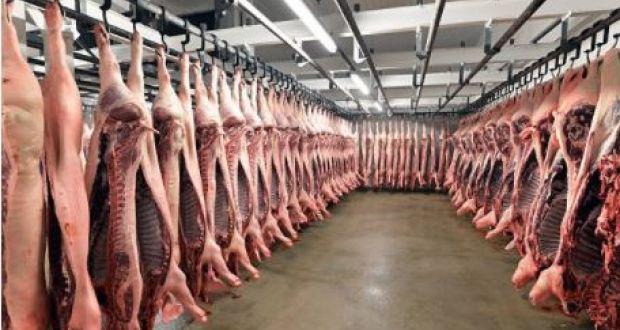Meat Processing Companies: Benefits of Electrocoagulation

While vegetarianism and veganism have both grown in popularity in the past decade, vegans and vegetarians combined are vastly outnumbered by people that love meat. In a country like the United States, where we have hot dog eating contests and food eating challenges, this country consumes a lot of meat of all types. Therefore, meat processing water treatment is required to package and process these foods within the US and across the world.
According to the North American Meat Institute, in 2017 the US meat and poultry industry processed:
42.2 billion pounds of chicken
26.3 billion pounds of beef
25.6 billion pounds of pork
5.9 billion pounds of turkey
From slaughterhouse to packaging, processing all of that meat requires copious amounts of water to produce hygienically safe cuts of meat from bacon to ribs to fillets to ham, chicken breast and more.
After slaughter, the animals are bled, removed of hide, hair or feathers, eviscerated, washed, trimmed, and dressed followed by secondary meat processing such as cutting, grinding, and deboning.
Aside from washing the meat itself, equipment and surfaces must also be cleaned and disinfected to meet federal and local sanitation standards and guidelines.
Billions of gallons of water are used annually in these processes and the wastewater is filled with biological contaminants that require treatment.
What’s in the Wastewater?
Based on the meat processing operations mentioned earlier, wastewater from these facilities contain organic and chemical constituents such as:
Fats/Oil/Grease (FOG)
Hair
Feces and Urine
Undigested food
Blood
Bacteria, Viruses, Cysts
Nitrogen and Phosphorus
Detergents and Disinfectants
Pollutants such as these can cause a number of issues. Pathogens and disinfectants cause adverse health effects in humans, animals, and plants.
Nitrogen and phosphorus can cause unmitigated plant growth which can lead to eutrophication while (FOG) can lead to clogged pipes and environmental issues.
Benefits of Electrocoagulation for Meat/Poultry Companies?
Electrocoagulation (EC) in wastewater treatment has been around for several decades. However, it has been within the past few years that it has gained recognition through improvements as a viable and effective treatment process.
In many industries, it has comparable, if not better treatment results over conventional chemical treatment. It is becoming known for its lower lifecycle costs in an integrated treatment system.
In the case of treating the wastewater from poultry and meat processing, it has a few key benefits.
Water reuse
More and more, industries are pressed to implement more sustainable practices, especially involving water use. As freshwater sources dwindle, decreasing water consumption becomes imperative. One way to reduce raw water demand is through reuse. In some cases, treatment systems that can treat wastewater to a reusable level can be large and costly, but with EC, systems can be modular, compact, and cost less. The EC process can substantially reduce several of the contaminants listed above all at once, leaving post clarification and polishing filtration and disinfection to complete the treatment. This treated water could be used for post-process cleaning, which can use a fair percentage of the total volume of water used during processing. As much raw water as facilities like these use in a year, they could typically cut back on costs significantly by reusing water instead.
Fecal coliform and Pathogen reduction
Fecal coliform in and of itself is not always harmful, but typically serves as an indicator of the presence of fecal matter and pathogenic substances. In the meat and poultry industry, fecal matter is almost certain to be present, along with pathogens like bacteria, cysts or viruses. Luckily, EC happens to be quite proficient at significantly reducing, if not completely eradicating these pathogenic substances. The electric fields produced by the electrodes can weaken cell membranes and make them more permeable and the overall charge neutralization allows the microorganisms to flocculate or adhere to larger particles and settle.
Fat/Oil/Grease (FOG) recycling
Fats, oils, and grease are commonplace wastes in the meat and poultry industry. Emulsified fat, oils and greases are effectively removed by EC thanks to its in situ destabilization of emulsions and flotation capabilities.
However, instead of being disposed of, these products can be recycled and processed for fuels instead, either on-site or sold to some other business for this purpose. FOG can also be used for heat energy, either directly as heat or converted to electrical energy.
Sludge
With high levels of solids in the wastewater, treatment will inevitably produce some volume of sludge. In chemical treatment processes, the sludge volume is typically high as chemical coagulation treatment is an additive process. This sludge is usually hazardous and has to be treated separately and disposed of carefully at extra cost to these facilities.
Typically, no such chemicals are needed in an EC system so there is less sludge produced, and it is typically nonhazardous. After dewatering, the EC sludge can be disposed of more easily and at lower cost. It can be sold to a local farm for land application.
All in all, electrocoagulation is an excellent treatment process for the meat processing and poultry industry.
Genesis Water Technologies specialized EC systems as part of an integrated treatment system, provide lower life cycle cost with lower sludge disposal costs and the ability to reduce production costs by enabling the reuse or safe discharge of water.
Considering EC for the treatment of meat processing or poultry wastewater? Contact Genesis Water Technologies at 1-877-267-3699 within the US or via email us at customersupport@genesiswatertech.com to setup a free initial consultation to discuss your specific application goals.

